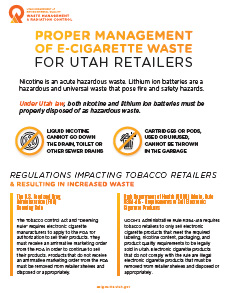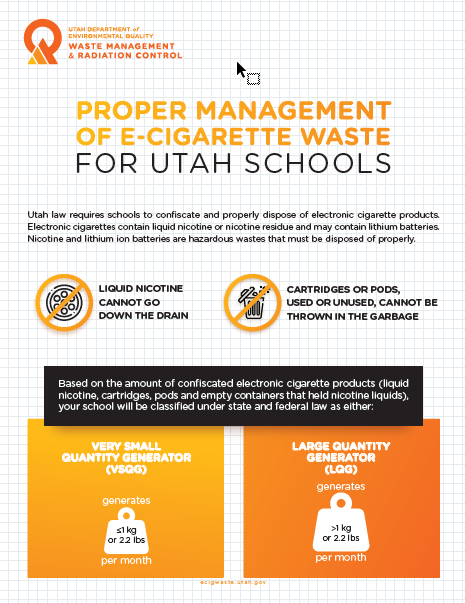Nicotine is an acute hazardous waste. Lithium ion batteries are a hazardous and universal waste that pose fire and safety hazards.
Under Utah law, both nicotine and lithium ion batteries must be properly disposed of as hazardous waste.
Related Links
Forms & Resources
Liquid nicotine cannot go down the drain, toilet or other sewer drains.
Cartridges or pods, used or unused, cannot be thrown in the garbage.
Retailer Requirements
Regulations Impacting Tobacco Retailers & Resulting In Increased Waste
The U.S. Food and Drug Administration (FDA) Deeming Rule
The Tobacco Control Act and “Deeming Rule” requires electronic cigarette manufacturers to apply to the FDA for authorization to sell their products. They must receive an affirmative marketing order from the FDA in order to continue to sell their products. Products that do not receive an affirmative marketing order from the FDA must be removed from retailer shelves and disposed of appropriately.
Utah Department of Health (UDOH) Admin. Rule R384-415 – Requirements to Sell Electronic Cigarette Products
UDOH’s Administrative Rule R384-415 requires tobacco retailers to only sell electronic cigarette products that meet the required labeling, nicotine content, packaging, and product quality requirements to be legally sold in Utah. Electronic cigarette products that do not comply with the rule are illegal electronic cigarette products that must be removed from retailer shelves and disposed of appropriately.
Determine Requirements That Apply To You
Waste management requirements under state and federal law for E-cigarette retailers depend on the amount of electronic cigarette products (liquid nicotine, cartridges, pods and empty containers that held nicotine liquids) and other acutely hazardous waste generated per month.
Category 1 Requirements
Generates LESS than or equal to 1 kg (2.2 lbs) per month
CATEGORY 2 REQUIREMENTS
Generates MORE than 1 kg (2.2 lbs) per month
Under The Hazardous Waste Generator Improvements Rule (R315-262-14)
- Ensure delivery of the hazardous waste to an offsite treatment or disposal facility permitted to manage hazardous waste, municipal or industrial solid waste, or a facility that recycles nicotine waste.
- Do not accumulate more than 1 kg (2.2 lbs) of acute hazardous waste at any time.
Under The Pharmaceuticals Rule (R315-266-500)
- Maintain containers used to accumulate waste nicotine and batteries so that they are structurally sound, compatible with the contents, and do not leak or are damaged in such a way that may result in a leak.Label e-cigarette waste containers with the words “Hazardous Waste Pharmaceuticals” and an indication of the hazards of nicotine (toxic) and lithium ion batteries (flammable).
- Keep containers closed and secured to prevent unauthorized access to the contents.
- Clean up and contain all nicotine spills immediately. The spill clean-up material must be managed as hazardous waste.
- Do not store nicotine waste for longer than one year, and be able to demonstrate how long the waste has been stored.
- Ship e-cigarette hazardous waste offsite to a permitted hazardous waste treatment, storage, or disposal facility using a uniform hazardous waste manifest. Keep a copy of each hazardous waste manifest for three years.
- Package, mark, and placard the containers according to Department of Transportation hazardous material transportation requirements.
- Train employees who manage hazardous waste nicotine so that they are thoroughly familiar with proper waste handling and emergency procedures during normal facility operations and emergencies.
- Notify the Division of Healthcare Facility status – under the EPA’s Pharmaceuticals Rule, all facilities that sell electronic nicotine products are defined as a Healthcare Facility. Use EPA Form 8700-12 and complete the applicable sections, including “D. pharmaceutical Activities”. Find the form at ecigwaste.utah.gov.
- Additional requirements include complying with land disposal restrictions and filing an exception report with the Division if a copy of the hazardous waste manifest is not received from the disposal facility the waste was sent to.
Handling E-Cigarette Waste
- Keep a spill kit stocked with binders (sand, diatomaceous earth, sawdust) and gloves nearby.
- Have a Safety Data Sheet for e-liquids available (this can be found via an internet search).
- Using gloves, place the e-liquids, cartridges, and pods in a container that is in good condition and has a lid that can be securely closed. Label the container with the words “Hazardous Waste Nicotine,” and “Danger – Toxic in contact with skin.”
- Keep a log of the amount of waste as it is collected, and make arrangements with a transporter and disposal company to pick up the waste BEFORE you accumulate the max limit (e.g. 1 kg for Category 1 requirements).
- Store lithium ion batteries away from heat and direct sunlight. Prevent terminals from touching by storing each battery in a plastic bag or by covering the terminals.
- Place damaged lithium ion batteries in a plastic bag and then place the bag in an inert material like sand. Lithium ion batteries that have an odor, are discolored, deformed, bulging, or swollen are damaged and have the potential to catch fire when they absorb moisture.
Properly Collect Battery Waste
All lithium ion batteries must be managed as either a hazardous waste, like nicotine waste, or sent to a universal waste handler or destination facility.
Universal waste batteries can only be accumulated for up to a year, so be sure to keep track of when the batteries began accumulating by marking the start date on the container.
Store waste batteries in a container with a lid that can be securely closed. Label the container with the words “Universal waste batteries,” “Waste batteries,” or “Used batteries.”
School Requirements
Determine Requirements That Apply To You
Based on the amount of confiscated electronic cigarette products (liquid nicotine, cartridges, pods and empty containers that held nicotine liquids), your school will be classified under state and federal law as either:
Category 1 Requirements
Generates LESS than or equal to 1 kg (2.2 lbs) per month
CATEGORY 2 REQUIREMENTS
Generates MORE than 1 kg (2.2 lbs) per month
Very Small Quantity Generator (VSQG) Requirements
- Ensure delivery of the hazardous waste to an offsite treatment or disposal facility permitted to manage hazardous waste, municipal or industrial waste, or a facility that recycles nicotine waste.
- Do not accumulate more than 1 kg (2.2 lbs) of e-cigarette products at any time.
Large Quantity Generator (LQG) Requirements
- Notify the Utah Division of Waste Management and Radiation Control of your hazardous waste activity and obtain an EPA identification number by contacting Kaci McNeill ([email protected]), (801) 536-0228.
- Maintain an internal communication or alarm system, telephone or two-way radio, and fire, spill control and decontamination equipment.
- Prepare and maintain a written hazardous waste contingency plan.
- Make arrangements with local police, fire, hospitals, and other emergency response organizations and familiarize them with your facility.
- Train all employees involved in hazardous waste management on their hazardous waste management duties and emergency response protocols.
- Store nicotine waste in labeled/marked storage containers that are in good condition.
- Store containers so that they do not rupture or leak and ensure that they remain closed except when adding or removing hazardous waste.
- Inspect hazardous waste containers weekly.
- Ship hazardous waste on a uniform hazardous waste manifest to a Resource Conservation and Recovery Act (RCRA) permitted hazardous waste treatment, storage, disposal facility (TSDF) within 90 days of reaching the 1 kg (2.2 lbs) limit.
- In even-numbered years, submit RCRA Subtitle C forms for the previous year by March 1. Forms can be submitted electronically using the RCRAInfo Industry Application, or emailing signed forms to [email protected].
Handling E-Cigarette Waste
- Keep a spill kit stocked with binders (sand, diatomaceous earth, sawdust) and gloves nearby.
- Have a Safety Data Sheet for e-liquids available (this can be found via an internet search).
- Using gloves, place the e-liquids, cartridges, and pods in a container that is in good condition and has a lid that can be securely closed. Label the container with the words “Hazardous Waste Nicotine,” and “Danger – Toxic in contact with skin.”
- Keep a log of the amount of waste as it is collected, and make arrangements with a transporter and disposal company to pick up the waste BEFORE you accumulate the max limit (e.g. 1 kg for Category 1 requirements).
- Store lithium ion batteries away from heat and direct sunlight. Prevent terminals from touching by storing each battery in a plastic bag or by covering the terminals.
- Place damaged lithium ion batteries in a plastic bag and then place the bag in an inert material like sand. Lithium ion batteries that have an odor, are discolored, deformed, bulging, or swollen are damaged and have the potential to catch fire when they absorb moisture.
Properly Collect Battery Waste
All lithium ion batteries must be managed as either a hazardous waste, like nicotine waste, or sent to a universal waste handler or destination facility.
Universal waste batteries can only be accumulated for up to a year, so be sure to keep track of when the batteries began accumulating by marking the start date on the container.
Store waste batteries in a container with a lid that can be securely closed. Label the container with the words “Universal waste batteries,” “Waste batteries,” or “Used batteries.”
Tools to Manage & Measure E-Cig Waste
Print Labels
E-cigarette waste container labels for retailers and schools are available to print and tape onto containers used to collect E-cigarette waste.
Track & Calculate
A printable tracking sheet and two online calculators are available to assist with E-cigarette nicotine waste tracking and to determine the weight of nicotine waste accumulated. These tools will help ensure proper measurement of monthly E-cig waste amounts and help the user determine when running totals go above the regulatory storage limits.
We recommend printing the tracking sheet and placing it next to the containers used to accumulate E-cigarettes.
Questions? Contact Us
- Utah Division of Waste Management & Radiation Control
(801) 536-0200 - Judy Moran ([email protected])
(385) 499-0184 - Deborah Ng ([email protected])
(385) 499-0837


